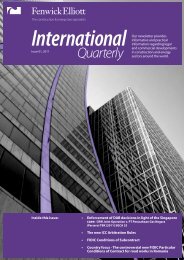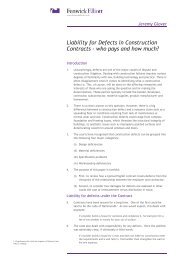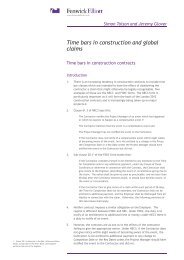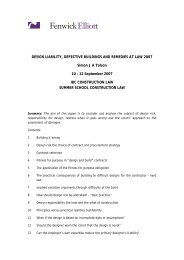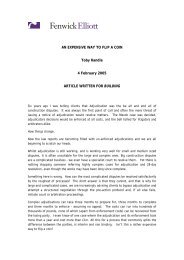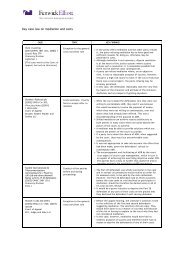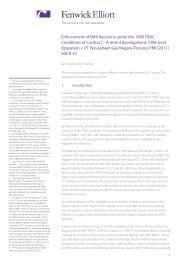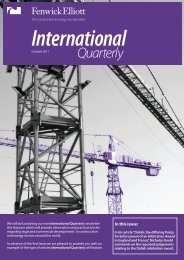CRW Joint Operation v. PT Perusahaan Gas Negara - Fenwick Elliott
CRW Joint Operation v. PT Perusahaan Gas Negara - Fenwick Elliott
CRW Joint Operation v. PT Perusahaan Gas Negara - Fenwick Elliott
Create successful ePaper yourself
Turn your PDF publications into a flip-book with our unique Google optimized e-Paper software.
Universal view:<br />
International contractual issues around the globe Issue 01 Winter 2011<br />
FIDIC Conditions of Subcontract<br />
By Jeremy Glover<br />
Partner, <strong>Fenwick</strong> <strong>Elliott</strong><br />
Quietly, in fact so quietly you may<br />
not have noticed, FIDIC has recently<br />
published its Conditions of Subcontract<br />
for Construction for use with the 1999<br />
FIDIC Red Book 1 . The test edition came<br />
out in 2009 with the formal version<br />
being released in October 2011. There<br />
have only been very minor changes<br />
between the two. The subcontract<br />
formally replaces the FIDIC Conditions<br />
of Subcontract for Works of Civil<br />
Engineering Construction, 1st Edition<br />
1994.<br />
In short the subcontract is intended to<br />
operate in the usual back-to-back basis,<br />
and, unsurprisingly, the subcontract<br />
provides for a direct total pass down of<br />
risk, with the subcontractor assuming the<br />
duties and obligations of the contractor<br />
under the main contract.<br />
This includes, at sub-cl.4.1, a fitness<br />
for purpose obligation in respect of<br />
any design work, something which is<br />
not in the 1994 version. This principle<br />
also applies to payment and one thing<br />
that will be of particular note to those<br />
familiar with operating in the UK market<br />
is inclusion of pay-when-paid conditions<br />
at sub-cl.14.6. These pay-when-paid<br />
provisions, of course, conflict with the<br />
payment requirements of the Housing<br />
Grants Act. FIDIC has included guidance<br />
notes and particular sample conditions<br />
to assist parties working in the UK and<br />
other jurisdictions with similar legislation.<br />
This is part of the general recognition<br />
on the part of FIDIC that while most of<br />
the clauses will be generally applicable,<br />
there may be some clauses which must,<br />
of necessity be amended to take account<br />
of the circumstances and locality of the<br />
Subcontract Works.<br />
One of the sub-clauses which provided<br />
much comment under the test edition,<br />
and which has been retained here, are<br />
the programming obligations under<br />
sub-cl.8.3 and Annex F. Indeed, whilst the<br />
programming obligations of sub-cl.8.3 of<br />
the main contract are fairly extensive, they<br />
are much less detailed than the<br />
the programming obligations under<br />
the FIDIC Subcontract 2011. These<br />
requirements are considerably more<br />
detailed both than those to be found<br />
in the 1994 version. This is even though<br />
sub-cl.8.5 notes that the Subcontractor<br />
monthly progress reports need only be<br />
in the same detail and format as the<br />
Contractor Reports. Annex F of the FIDIC<br />
Subcontract 2011 alone lists some 17<br />
separate requirements, a-q. These include<br />
logically linking all activities, identifying<br />
the critical path and all float, as well as<br />
including sufficient flexibility to interface<br />
the Subcontractor’s activities with the<br />
Contractor. The Subcontract programme<br />
must be submitted to the Contractor<br />
within 14 days of receiving the Letter<br />
of Acceptance. Then the Contactor has<br />
14 days to either approve or reject the<br />
programme. If the Contractor fails to<br />
respond then the initial programme<br />
becomes the Subcontract programme<br />
by default. The programme must be<br />
updated within seven days of the<br />
occurrence of one of six-listed events<br />
including the Subcontractor changing<br />
his methods or sequencing, there being<br />
any delay which impacts on the critical<br />
path or the Subcontractor receiving from<br />
the Contractor an instruction, pursuant<br />
to sub-cl.8.4 to accelerate where the<br />
Subcontractor’s progress is too slow.<br />
Employers under the FIDIC Red Book 1999,<br />
may well, if they are not already, start<br />
requiring a similar level of detail from the<br />
Contractor.<br />
Subcontractor claims<br />
As always, FIDIC has given considerable<br />
attention to the dispute resolution<br />
provisions. The subcontract contains<br />
its own dispute resolution procedures<br />
but as you would expect, the claims<br />
procedure for Subcontractors set out<br />
in the FIDIC Subcontract 2011 follows<br />
the scheme of the FIDIC Red Book 1999.<br />
1<br />
It is also intended to be used in conjunction with the FIDIC Conditions of Contract for Construction, MDB Harmonised Edition or Pink Book. However if this is the case<br />
both parties must take care to ensure that the subcontract has been amended to mirror the differences between the Pink and Red Books.



